博文
科研风波再起:方舟子公开叫板韩春雨
 精选
精选
||
科研风波再起:方舟子公开叫板韩春雨
(london-science.com原创,未经授权,禁止转载。原文:http://www.london-science.com/archives/451)
5月3日,来自河北科技大学的韩春雨老师在Nature Biotechnology上发表了关于新型基因编辑技术NgAgo的论文,轰动学术界,他的研究成果也被称为是“诺贝尔奖级别”。韩春雨老师在经费短缺,设备落后的条件下潜心钻研,多年来在学术界默默无闻,却做出了意义重大的研究成果-他因此也被媒体大幅报道,被许多人奉为科研榜样,成为了学术界的“网红”。然而,方舟子在6月30日发表文章,声称韩春雨的实验成果存在“不可重复复制操作”的问题,暗指韩春雨科研成果的真实性。韩春雨在公开场合的言论与他在论文里的描述存在诸多矛盾,韩春雨曾在北大的演讲中提出他的实验NgAgo是初级版、需要高超的实验技巧,而方舟子认为韩春雨描述的只是个并不复杂的转染实验,是现成的技术,并不需要高超的实验技巧,按照其提供的步骤应该是不难被重复出来的才对,而不应该出现“没法重复该实验” 的情况。
其实,早在5月份,颜宁教授对韩春雨老师研究成果的评论就曾引发了巨大争议。颜宁教授称这项研究结果并不属于原创,她的一系列微博也让舆论沸腾。她声称:“到了这一步终于变味了。上周组会的点评:1.我很佩服韩老师,在支持这么差的情况下坚持科研,真心佩服;2.希望借此能够关注对于本土培养的青年科学家的支持问题;3.这个研究如果所有数据solid,前景巨大,好极了;4.这项研究不属于创新型研究,是跟风型的,没必要神话,原创在2014年。”
科研道路的艰辛,常人难以理解。真理之路是漫长的,只有时间能证明一切。
原文:河北科技大学韩春雨“诺贝尔奖级”实验的重复性问题
注:1. 图3,图4指的是韩春雨论文中的figure 3,figure 4, 原图片见最下方。
2. 韩春雨论文原文 DNA-guided genome editing using the Natronobacterium gregoryi Argonaute,发表在Nature Biotechnology。
一个新的科学发现、技术,需要经过别人的重复才得到公认。别人重复不出来,有疑问,是很正常的。作为首创者应该做的是去消除疑问,而不是攻击、谩骂,否则那更让人怀疑。
不久前河北科技大学韩春雨在《自然·生物技术》发表论文报告了一种基因编辑新方法NgAgo,在国内轰动一时。被《知识分子》作为末流学校土博士也能做世界一流科研的典型,国内其他媒体随后跟进宣传,甚至称之为“诺贝尔奖级”的研究成果。
这几天我陆续收到几家实验室的研究人员的来信,反映重复不出韩春雨论文中最关键的图4结果(切割基因组,T7E1和测序),呼吁我关注一下这事。
有些人已在网上生物专业论坛公开讨论此事,报告他们没法重复该实验,询问有谁重复出来了。目前还未见有人反映重复出了图4结果。有的能够重复论文中的图3结果(FACS和Western Blot),但那有可能是假阳性。
据听报告的人说,韩春雨在北大和遗传所的报告上都强调,他目前的NgAgo是初级版、需要高超的实验技巧、等他推出2.0版和Smart版。这些说法跟他在论文里的描述是矛盾的。因为他描述的只是个并不复杂的转染实验,T7E1和测序也都是现成的技术,并不需要高超的实验技巧,按照其提供的步骤应该是不难被重复出来的。
韩春雨获悉有人重复不出其实验结果后,不是解答疑惑,而是谩骂这些人是“跳梁小丑”、是搞别的基因编辑技术(CRISPR)的人的抹黑,威胁要对他们进行人肉搜索。
我当然不怕被人肉,也不怕挨骂,所以在此问几个问题:
第一,有没有人重复出了韩春雨论文中的图4结果?有的话跟我说一下。
第二,据称韩春雨在遗传所的报告上说,重复出来和不能重复的比例是1:3,能重复出来的有20家。那么究竟有哪家实验室重复出来了?(指图4结果)这事没必要保密吧。
第三,韩春雨说做这个实验“需要高超的实验技巧”,那么究竟在哪个步骤需要什么样的高超实验技巧?
为什么一个新实验的结果别人都反映重复不出来,原因很多,比如可能是重复出来的都不吭声,重复不出来的实验技术不行,论文中隐瞒了关键的“实验技巧”(这不道德),或者论文报告的结果干脆就是编的(这更不道德)。一个新的科学发现、技术,需要经过别人的重复才得到公认。别人重复不出来,有疑问,是很正常的。作为首创者应该做的是去消除疑问,而不是攻击、谩骂,否则那更让人怀疑。
下面为图3的图片与对应注释
Figure 3 NgAgo works as an endonuclease and can cleave DNA targets in vivo.
(a) Electrophoresis of target pACYCDuet eGFP plasmid after it was incubated with purified NgAgo,
preloaded with FW guide in 293T cells for 4 h, 8 h or 72 h. Representative results from three independent experiments.
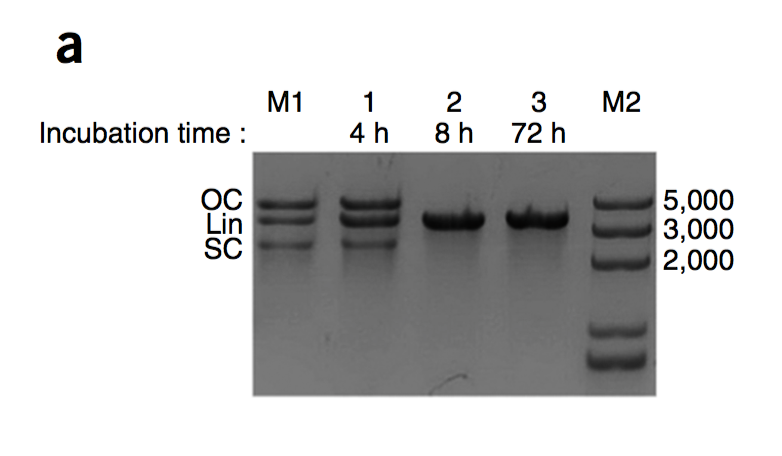
(b) Examples of sequencing results from the plasmid cleavage products of NgAgo after 72-h incubation, which shows that 1−20 nucleotides within the guide/target region were randomly removed. Representative sequencing results from 20 independent experiments.
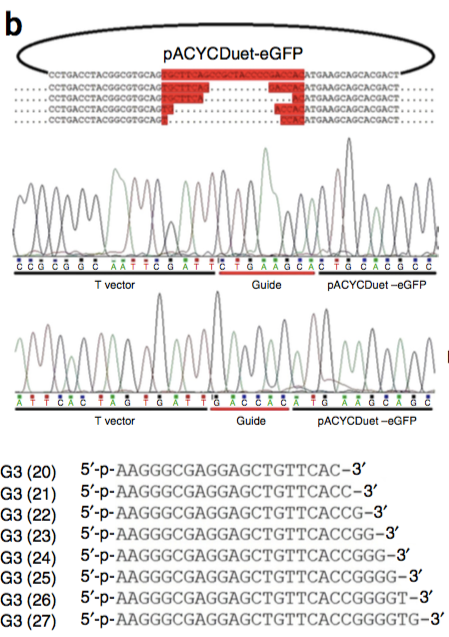
(c) Schematic (top) shows the positions of ssDNA guides for NgAgo and sgRNA for Cas9 on the target plasmid pEGFPN1. Western blot analysis (below) of eGFP expression in HeLa cells transfected with pEGFP-N1 target plasmid together with either the NgAgo-expressing plasmid and the indicated ssDNA guides, or Cas9-expressing plasmid and the indicated sgRNA transcription vectors. Densitometric ratios between eGFP and actin bands are shown below the blot. Representative of three independent experiments.
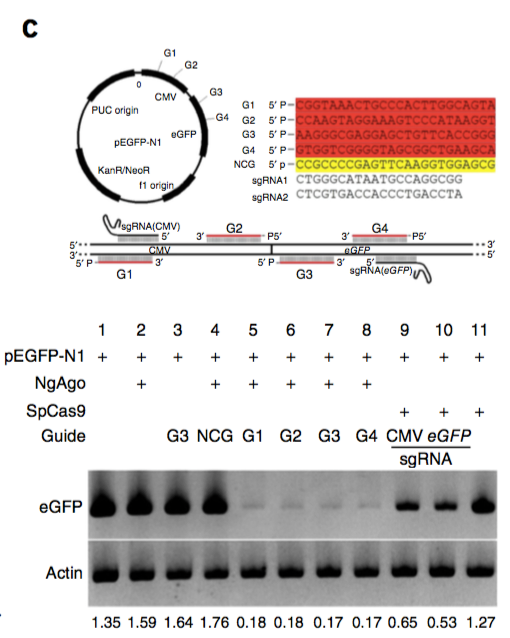
(d) Western blot analysis of eGFP expression in HeLa cells transfected with pEGFP-N1 target plasmid, NgAgoencoding plasmid and the G3 guide of various lengths (n). Blot is representative of three independent experiments. Fulllength gels and blots are presented in Supplementary Figure 9.

下面为图4的图片与对应注释
Figure 4 NgAgo can make targeted double-strand breaks in mammalian genome.
(a) Schematic of the guides corresponding to the loci of the exon 11 of human DYRK1A gene (top). T7E1 assay (middle) for NgAgo-mediated insertion-deletions (indels). Arrows show the anticipated positions of T7E1 products. The control is normal 293T cell genomic DNA. Example chromatogram showing microdeletion as well as representative sequences of mutated alleles identified from clonal amplicons by using G10 guide (bottom).
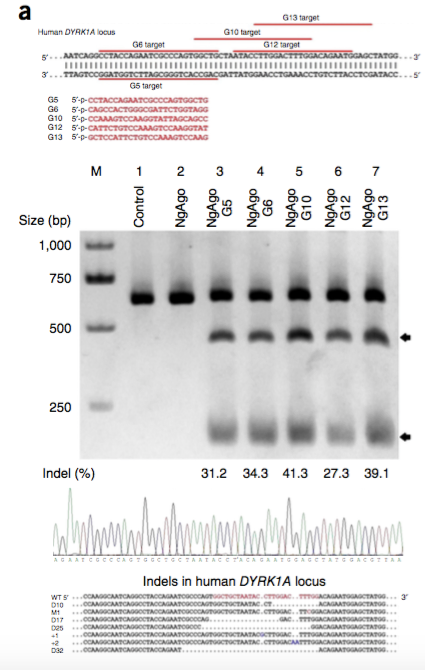
WT, wild type; D, deletions; M, mutations; +, insertions. (b,c) T7E1 assays of NgAgo-mediated indels at the indicated targets in human genome (b) and at the DYRK1A gene in the indicated cell lines (c).
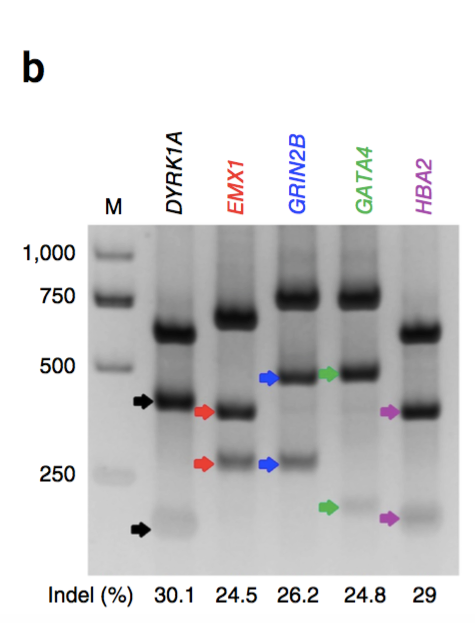

(d) T7E1 assay of G10 guide with indicated nucleotide mismatches (marked in red).
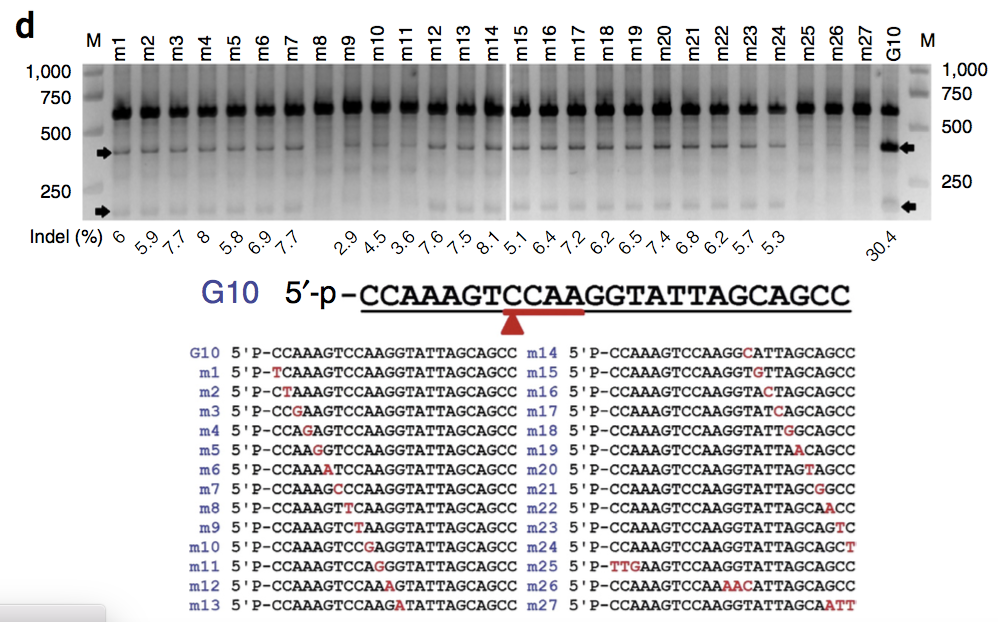
(e,f) Comparison of the efficiency between NgAgo-gDNA system and Cas9-sgRNA system in cleaving the human DYRK1A gene (e), and the (G+C)-rich sequences at HBA2 and GATA4 genes (f). The controls were normal 293T cell genomic DNA. Data in b−f are representative of three independent experiments. Full-length gels are presented in Supplementary Figure 9.

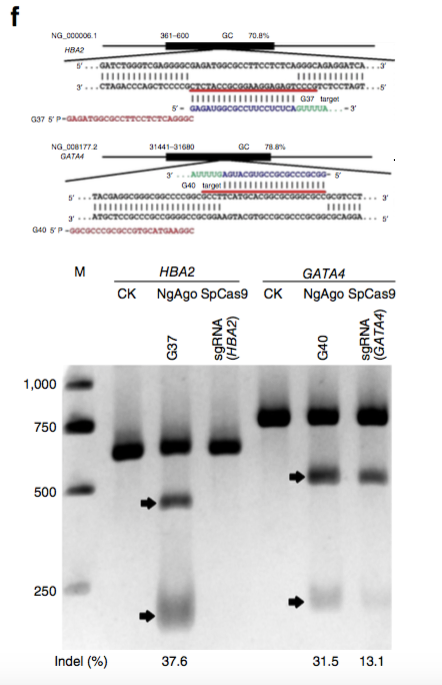
方舟子文章:http://fangzhouzi.baijia.baidu.com/article/523403
图片来自:DNA-guided genome editing using the Natronobacterium gregoryi Argonaute
韩春雨事件
https://wap.sciencenet.cn/blog-3160644-988470.html
上一篇:【最新】Nature: 抗体验证,不容懈怠
下一篇:【最新】韩春雨回应方舟子的质疑
全部作者的精选博文
全部作者的其他最新博文
全部精选博文导读
相关博文
- • 聚英才 建高地 | 北京理工大学“特立青年学者”全球招聘开启
- • 700年后日本或濒临灭绝?日本学者推算预测:届时或仅剩1名15岁以下孩子
- • [转载]【同位素视角】非英语母语学者如何区分’e.g.’, ‘i.e.’, ‘namely’与‘such as’等混淆难题
- • 美国佐治亚大学等机构学者:刈割策略对Bulldog 805紫花苜蓿+Tifton 85狗牙根混播草地产量及品质的影响
- • 美国堪萨斯州立大学、密苏里大学等机构学者研究成果:土壤水分管理策略和品种多样性对紫花苜蓿产量、营养品质和农场盈利能力的影
- • 德国、捷克草业科学学者长期放牧实验:异质草地斑块中的土壤有机碳储量和地下生物量